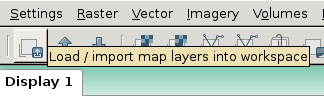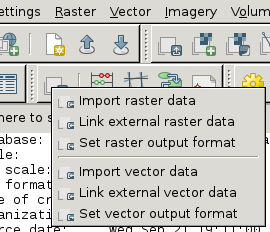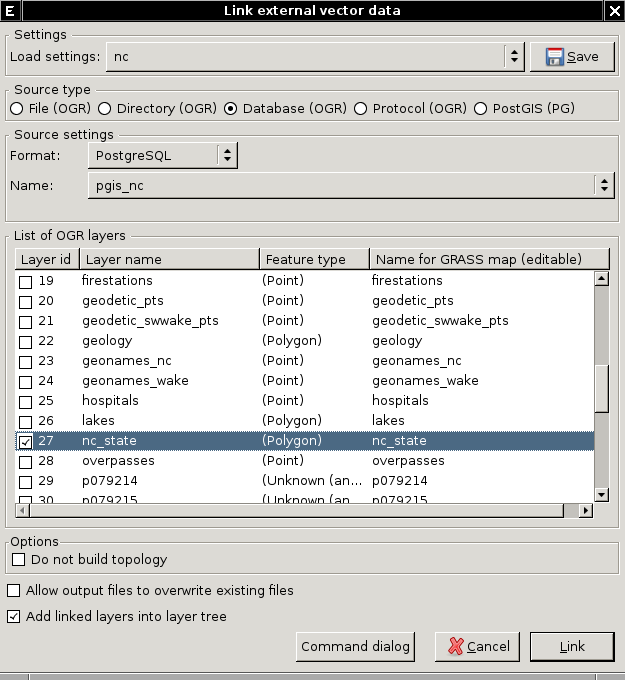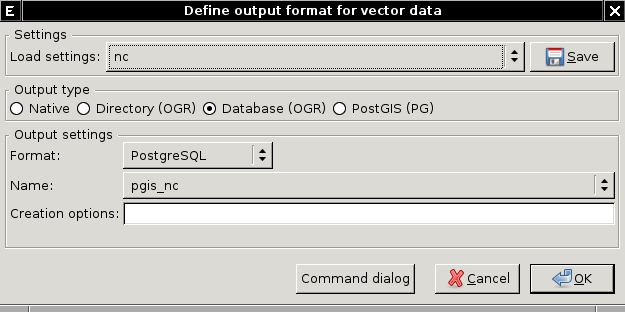Working with external data in GRASS 7: Difference between revisions
m (Updated link to OGR's PostgreSQL / PostGIS driver page) |
|||
| (15 intermediate revisions by 2 users not shown) | |||
| Line 1: | Line 1: | ||
This page explains how to effectively work with external raster and vector data in GRASS 7. See also [[PostGIS]] and [[PostGIS Topology]]. | |||
This page explains how to work with external data in GRASS 7. See also [[PostGIS]]. | |||
__TOC__ | __TOC__ | ||
== Raster data == | == Raster data == | ||
External raster data can be linked via {{cmd | External raster data can be linked via {{cmd|r.external}}. List of supported formats can be determined by | ||
{{cmd|r.external | {{cmd|r.external}} -f | ||
To link file-based data formats, eg. GeoTiff | To link file-based data formats, eg. GeoTiff | ||
{{cmd|r.external | {{cmd|r.external}} input=ncrast/urban.tif output=urban | ||
=== Raster data processing workflow when keeping data external === | |||
External raster maps can directly be linked into GRASS with {{cmd|r.external}} which saves time and disk space. Additionally, there is no more a need to store results in the internal GRASS format - with {{cmd|r.external.out}} the resulting maps are directly written to a GDAL supported format. | |||
'''Preparations''' | |||
GRASS can be used in an automated way by just defining a set of variables. See here for [[GRASS_and_Shell#Setting_the_variables|GRASS and Shell]] settings and [[GRASS_and_Python#Creating_Python_scripts_that_call_GRASS_functionality_from_outside|GRASS and Python]]. | |||
'''Data flow example''' | |||
The script content could be looking like this: | |||
<source lang="bash"> | |||
# register (rather than import) a GeoTIFF file in GRASS GIS: | |||
r.external input=terra_lst1km20030314.LST_Day.tif output=modis_celsius | |||
# define output directory for files resulting from subsequent calculations: | |||
r.external.out directory=$HOME/gisoutput/ format="GTiff" | |||
# perform calculations (here: extract pixels > 20 deg C) | |||
# store output directly as GeoTIFF file, hence add the .tif extension: | |||
r.mapcalc "warm.tif = if(modis_celsius > 20.0, modis_celsius, null() )" | |||
# cease GDAL output connection and turn back to write standard GRASS raster files: | |||
r.external.out -r | |||
# use the result elsewhere | |||
qgis $HOME/gisoutput/warm.tif | |||
</source> | |||
== Vector data == | == Vector data == | ||
| Line 18: | Line 47: | ||
=== Link external data === | === Link external data === | ||
External vector data can be linked via {{cmd | External vector data can be linked via {{cmd|v.external}} using [http://gdal.org/ogr OGR library] or ''GRASS-PostGIS data driver'' (<tt>format=PostgreSQL</tt>). List of supported formats can be determined by | ||
{{cmd|v.external | {{cmd|v.external}} -f | ||
To link ''file-based data formats'', eg. [http://gdal.osgeo.org/ogr/drv_shapefile.html ESRI Shapefile] using OGR library | To link ''file-based data formats'', eg. [http://gdal.osgeo.org/ogr/drv_shapefile.html ESRI Shapefile] using OGR library | ||
{{cmd|v.external | {{cmd|v.external}} input=ncshape/ layer=railroads | ||
Assuming that <tt>railroads.shp</tt> is located in directory <tt>ncshape</tt>. | Assuming that <tt>railroads.shp</tt> is located in directory <tt>ncshape</tt>. | ||
| Line 30: | Line 59: | ||
To link ''database-based data formats'', eg. [http://gdal.osgeo.org/ogr/drv_pg.html PostGIS] using GRASS-PostGIS data driver | To link ''database-based data formats'', eg. [http://gdal.osgeo.org/ogr/drv_pg.html PostGIS] using GRASS-PostGIS data driver | ||
{{cmd|v.external | {{cmd|v.external}} input=PG:dbname=pgis_nc -l | ||
PostGIS database <pgis_nc> contains 55 feature table(s): | PostGIS database <pgis_nc> contains 55 feature table(s): | ||
| Line 37: | Line 66: | ||
... | ... | ||
{{cmd|v.external | {{cmd|v.external}} input=PG:dbname=pgis_nc layer=bridges output=b | ||
Assuming PostGIS layer named <tt>bridges</tt> is located in database <tt>pgis_nc</tt>. This layer is linked to GRASS mapset as vector map with name <tt>b</tt>. {{cmd|v.external | Assuming that PostGIS layer named <tt>bridges</tt> is located in database <tt>pgis_nc</tt>. This layer is linked to GRASS mapset as vector map with name <tt>b</tt>. {{cmd|v.external}} also builds pseudo-topology over simple features which enables GRASS to access linked vector data on level 2. Note that data are stored as simple features, so no full topology support can be build based on this data. | ||
PostGIS feature tables are | By default PostGIS feature tables are linked using built-in '''GRASS-PostGIS data driver''' - it means that PostGIS geometry data are accessed by GRASS directly without any abstract level (like OGR library). When GRASS is built without PostgreSQL support or environmental variable <tt>GRASS_VECTOR_OGR</tt> exists, then GRASS will access PostGIS data using [http://www.gdal.org/drv_pg.html OGR-PostgreSQL] driver. | ||
=== Direct access to external data === | === Direct access to external data === | ||
| Line 47: | Line 76: | ||
External data can be accessed using OGR library via ''virtual'' mapset <tt>OGR</tt>. | External data can be accessed using OGR library via ''virtual'' mapset <tt>OGR</tt>. | ||
{{cmd|v.info | {{cmd|v.info}} map=PG:dbname=pgis_nc@OGR layer=bridges | ||
Direct access using GRASS-PostGIS data driver is not currently possible. | Direct access using GRASS-PostGIS data driver is not currently possible. | ||
| Line 55: | Line 84: | ||
==== v.extract showcase ==== | ==== v.extract showcase ==== | ||
GRASS 7 also supports write access to the external data using OGR or GRASS-PostGIS data driver. Showcase bellow: | |||
{{cmd|v.external}} input=PG:dbname=pgis_nc layer=bridges output=b | |||
{{cmd|v.out.ascii}} input=b where="cat < 10" --q | |||
{{cmd|v.out.ascii | |||
375171.4992779|317756.72097616|1 | 375171.4992779|317756.72097616|1 | ||
| Line 77: | Line 100: | ||
376739.6982779|315970.62597616|9 | 376739.6982779|315970.62597616|9 | ||
{{cmd|v.external.out | {{cmd|v.external.out}} input=PG:dbname=pgis_nc format=PostgreSQL | ||
{{cmd|v.extract}} input=b output=b_9 where="cat < 10" | |||
{{cmd|v.external | {{cmd|v.external}} input=PG:dbname=pgis_nc -l | ||
PostGIS database <pgis_nc> contains 56 feature table(s): | |||
b_9 | b_9 | ||
bridges | bridges | ||
| Line 96: | Line 114: | ||
Example of direct access to external data without creating a link (only OGR data driver) | Example of direct access to external data without creating a link (only OGR data driver) | ||
{{cmd|v.out.ascii | {{cmd|v.out.ascii}} input=PG:dbname=pgis_nc@OGR layer=b_9 | ||
375171.4992779|317756.72097616|1 | 375171.4992779|317756.72097616|1 | ||
| Line 112: | Line 130: | ||
Check connection settings: | Check connection settings: | ||
(for OGR data driver) | (for GRASS-OGR data driver) | ||
{{cmd|v.external.out | {{cmd|v.external.out}} -p | ||
dsn: | dsn: /path/to/shapefiles | ||
format: | format: ESRI Shapefile | ||
(for PostGIS data driver) | (for GRASS-PostGIS data driver) | ||
{{cmd|v.external.out | {{cmd|v.external.out}} -p | ||
conninfo: dbname=pgis_nc | conninfo: dbname=pgis_nc | ||
format: PostGIS | format: PostGIS | ||
New OGR/PostGIS layer can be created using {{cmd|v.edit | New OGR/PostGIS layer can be created using {{cmd|v.edit}}, note that you need to specify feature type for newly created OGR/PostGIS layer (point, line or boundary). | ||
{{cmd|v.edit | {{cmd|v.edit}} map=pmap tool=create type=point | ||
Check created OGR layer (direct access, OGR data driver only): | Check created OGR layer (direct access, OGR data driver only): | ||
{{cmd|v.info | {{cmd|v.info}} -t map=PG:dbname=pgis_nc@OGR layer=pmap | ||
... | ... | ||
| Line 140: | Line 158: | ||
Check created OGR/PostGIS layer (link): | Check created OGR/PostGIS layer (link): | ||
{{cmd|v.external}} input=PG:dbname=pgis_nc layer=pmap | |||
{{cmd|v.info}} -t map=pmap | |||
{{cmd|v.info | |||
Adding new point feature: | Adding new point feature: | ||
| Line 158: | Line 170: | ||
1 1 | 1 1 | ||
{{cmd|v.edit | {{cmd|v.edit}} -n map=pmap tool=add input=point.txt | ||
{{cmd|v.info | {{cmd|v.info}} -t map=pmap | ||
... | ... | ||
| Line 171: | Line 183: | ||
* DBF input (attributes only) | * DBF input (attributes only) | ||
{{cmd|g.mapset | {{cmd|g.mapset}} user1 | ||
{{cmd|db.connect | {{cmd|db.connect}} -p | ||
driver:dbf | driver:dbf | ||
database:$GISDBASE/$LOCATION_NAME/$MAPSET/dbf/ | database:$GISDBASE/$LOCATION_NAME/$MAPSET/dbf/ | ||
{{cmd|g.copy | {{cmd|g.copy}} vect=bridges,b --o | ||
{{cmd|g.copy | {{cmd|g.copy}} vect=urbanarea,u --o | ||
* SQLite input (attributes only) | * SQLite input (attributes only) | ||
{{cmd|g.mapset | {{cmd|g.mapset}} sqlite | ||
{{cmd|db.connect | {{cmd|db.connect}} -p | ||
driver:sqlite | driver:sqlite | ||
database:$GISDBASE/$LOCATION_NAME/$MAPSET/sqlite.db | database:$GISDBASE/$LOCATION_NAME/$MAPSET/sqlite.db | ||
{{cmd|g.copy | {{cmd|g.copy}} vect=bridges,b --o | ||
{{cmd|g.copy | {{cmd|g.copy}} vect=urbanarea,u --o | ||
* Export data to PostGIS database (from mapset 'sqlite') | * Export data to PostGIS database (from mapset 'sqlite') | ||
{{cmd|v.out.ogr | {{cmd|v.out.ogr}} input=b input=PG:dbname=pgis_nc format=PostgreSQL olayer=bridges --o | ||
{{cmd|v.out.ogr | {{cmd|v.out.ogr}} input=u input=PG:dbname=pgis_nc format=PostgreSQL olayer=urbanarea --o | ||
* PostGIS input (geometry + attributes) - OGR data driver | * PostGIS input (geometry + attributes) - OGR data driver | ||
{{cmd|g.mapset | {{cmd|g.mapset}} pg_ogr | ||
{{cmd|v.external | export GRASS_VECTOR_OGR=1 | ||
{{cmd|v.external | {{cmd|v.external}} input=PG:dbname=pgis_nc layer=bridges output=b --o | ||
{{cmd|v.external}} input=PG:dbname=pgis_nc layer=urbanarea output=u --o | |||
* PostGIS input (geometry + attributes) - PostGIS data driver | * PostGIS input (geometry + attributes) - GRASS-PostGIS data driver | ||
{{cmd|g.mapset | {{cmd|g.mapset}} pg | ||
{{cmd|v.external | {{cmd|v.external}} input=PG:dbname=pgis_nc layer=bridges output=b --o | ||
{{cmd|v.external | {{cmd|v.external}} input=PG:dbname=pgis_nc layer=urbanarea output=u --o | ||
Writing output directly using OGR library (mapset 'pg_ogr'): | Writing output directly using OGR library (mapset 'pg_ogr'): | ||
{{cmd|v.external.out | {{cmd|v.external.out}} -p | ||
dsn: PG:dbname=pgis_nc | dsn: PG:dbname=pgis_nc | ||
| Line 217: | Line 230: | ||
Writing output directly using PostGIS data driver (mapset 'pg'): | Writing output directly using PostGIS data driver (mapset 'pg'): | ||
{{cmd|v.external.out | {{cmd|v.external.out}} -p | ||
conninfo: dbname=pgis_nc | conninfo: dbname=pgis_nc | ||
format: | format: PostgreSQL | ||
* DBF input | * DBF input | ||
time {{cmd|v.select | time {{cmd|v.select}} ain=b@user1 atype=point bin=u@user1 btype=area out=b_u ope=overlap --o | ||
real 0m6.059s | real 0m6.059s | ||
| Line 232: | Line 245: | ||
* SQLite input | * SQLite input | ||
time {{cmd|v.select | time {{cmd|v.select}} ain=b@sqlite atype=point bin=u@sqlite btype=area out=b_u ope=overlap --o | ||
real 0m2.239s | real 0m2.239s | ||
| Line 240: | Line 253: | ||
* PostGIS input | * PostGIS input | ||
time {{cmd|v.select | time {{cmd|v.select}} ain=b atype=point bin=u btype=area out=b_u ope=overlap --o | ||
real 0m20.609s | real 0m20.609s | ||
| Line 269: | Line 282: | ||
[[Image:wxgui-link-menu.png|center|frame|Link external data - Layer Manager menu]] | [[Image:wxgui-link-menu.png|center|frame|Link external data - Layer Manager menu]] | ||
or from ''toolbar'' in Layer Manager. | or from ''toolbar'' in Layer Manager. | ||
| Line 276: | Line 287: | ||
[[Image:wxgui-link-tooltip.png|center|frame|Link external data - Layer Manager toolbar (1)]] | [[Image:wxgui-link-tooltip.png|center|frame|Link external data - Layer Manager toolbar (1)]] | ||
[[Image:wxgui-link-tool.png|center|frame|Link external data - Layer Manager toolbar (2)]] | [[Image:wxgui-link-tool.png|center|frame|Link external data - Layer Manager toolbar (2)]] | ||
[[Image:wxgui-v.external.png|center|thumb|400px|wxGUI {{cmd|v.external | [[Image:wxgui-v.external.png|center|thumb|400px|wxGUI {{cmd|v.external}} dialog]] | ||
[[Image:wxgui-v.external.out.png|center|thumb|400px|wxGUI {{cmd|v.external.out | [[Image:wxgui-v.external.out.png|center|thumb|400px|wxGUI {{cmd|v.external.out}} dialog]] | ||
== See also == | |||
* [[PostGIS]] | |||
* [[PostGIS Topology]] | |||
[[Category:Vector]] | |||
[[Category:FAQ]] | |||
[[Category:GRASS 7]] | |||
Latest revision as of 09:15, 8 May 2018
This page explains how to effectively work with external raster and vector data in GRASS 7. See also PostGIS and PostGIS Topology.
Raster data
External raster data can be linked via r.external. List of supported formats can be determined by
r.external -f
To link file-based data formats, eg. GeoTiff
r.external input=ncrast/urban.tif output=urban
Raster data processing workflow when keeping data external
External raster maps can directly be linked into GRASS with r.external which saves time and disk space. Additionally, there is no more a need to store results in the internal GRASS format - with r.external.out the resulting maps are directly written to a GDAL supported format.
Preparations
GRASS can be used in an automated way by just defining a set of variables. See here for GRASS and Shell settings and GRASS and Python.
Data flow example
The script content could be looking like this:
# register (rather than import) a GeoTIFF file in GRASS GIS:
r.external input=terra_lst1km20030314.LST_Day.tif output=modis_celsius
# define output directory for files resulting from subsequent calculations:
r.external.out directory=$HOME/gisoutput/ format="GTiff"
# perform calculations (here: extract pixels > 20 deg C)
# store output directly as GeoTIFF file, hence add the .tif extension:
r.mapcalc "warm.tif = if(modis_celsius > 20.0, modis_celsius, null() )"
# cease GDAL output connection and turn back to write standard GRASS raster files:
r.external.out -r
# use the result elsewhere
qgis $HOME/gisoutput/warm.tif
Vector data
See trac OGR interface and PG interface page for development issues.
Link external data
External vector data can be linked via v.external using OGR library or GRASS-PostGIS data driver (format=PostgreSQL). List of supported formats can be determined by
v.external -f
To link file-based data formats, eg. ESRI Shapefile using OGR library
v.external input=ncshape/ layer=railroads
Assuming that railroads.shp is located in directory ncshape.
To link database-based data formats, eg. PostGIS using GRASS-PostGIS data driver
v.external input=PG:dbname=pgis_nc -l
PostGIS database <pgis_nc> contains 55 feature table(s):
...
bridges
...
v.external input=PG:dbname=pgis_nc layer=bridges output=b
Assuming that PostGIS layer named bridges is located in database pgis_nc. This layer is linked to GRASS mapset as vector map with name b. v.external also builds pseudo-topology over simple features which enables GRASS to access linked vector data on level 2. Note that data are stored as simple features, so no full topology support can be build based on this data.
By default PostGIS feature tables are linked using built-in GRASS-PostGIS data driver - it means that PostGIS geometry data are accessed by GRASS directly without any abstract level (like OGR library). When GRASS is built without PostgreSQL support or environmental variable GRASS_VECTOR_OGR exists, then GRASS will access PostGIS data using OGR-PostgreSQL driver.
Direct access to external data
External data can be accessed using OGR library via virtual mapset OGR.
v.info map=PG:dbname=pgis_nc@OGR layer=bridges
Direct access using GRASS-PostGIS data driver is not currently possible.
Create new OGR layers using GRASS modules
v.extract showcase
GRASS 7 also supports write access to the external data using OGR or GRASS-PostGIS data driver. Showcase bellow:
v.external input=PG:dbname=pgis_nc layer=bridges output=b
v.out.ascii input=b where="cat < 10" --q
375171.4992779|317756.72097616|1
374247.5192779|317487.13697616|2
380230.2292779|316900.97897616|3
379191.4162779|316419.09697616|4
388958.8222779|316332.04697616|5
375875.2662779|316319.89597616|6
376393.5282779|316155.96797616|7
380647.5282779|316022.61797616|8
376739.6982779|315970.62597616|9
v.external.out input=PG:dbname=pgis_nc format=PostgreSQL
v.extract input=b output=b_9 where="cat < 10"
v.external input=PG:dbname=pgis_nc -l
PostGIS database <pgis_nc> contains 56 feature table(s):
b_9
bridges
...
Example of direct access to external data without creating a link (only OGR data driver)
v.out.ascii input=PG:dbname=pgis_nc@OGR layer=b_9
375171.4992779|317756.72097616|1
374247.5192779|317487.13697616|2
380230.2292779|316900.97897616|3
379191.4162779|316419.09697616|4
388958.8222779|316332.04697616|5
375875.2662779|316319.89597616|6
376393.5282779|316155.96797616|7
380647.5282779|316022.61797616|8
376739.6982779|315970.62597616|9
Create new empty OGR/PostGIS layer
Check connection settings:
(for GRASS-OGR data driver)
v.external.out -p
dsn: /path/to/shapefiles
format: ESRI Shapefile
(for GRASS-PostGIS data driver)
v.external.out -p
conninfo: dbname=pgis_nc
format: PostGIS
New OGR/PostGIS layer can be created using v.edit, note that you need to specify feature type for newly created OGR/PostGIS layer (point, line or boundary).
v.edit map=pmap tool=create type=point
Check created OGR layer (direct access, OGR data driver only):
v.info -t map=PG:dbname=pgis_nc@OGR layer=pmap
...
points=0
...
Check created OGR/PostGIS layer (link):
v.external input=PG:dbname=pgis_nc layer=pmap
v.info -t map=pmap
Adding new point feature:
cat point.txt P 1 1 375171.4992779 317756.72097616 1 1
v.edit -n map=pmap tool=add input=point.txt v.info -t map=pmap ... points=1 ...
v.select speed test
Testing data:
- DBF input (attributes only)
g.mapset user1 db.connect -p driver:dbf database:$GISDBASE/$LOCATION_NAME/$MAPSET/dbf/
g.copy vect=bridges,b --o g.copy vect=urbanarea,u --o
- SQLite input (attributes only)
g.mapset sqlite db.connect -p driver:sqlite database:$GISDBASE/$LOCATION_NAME/$MAPSET/sqlite.db
g.copy vect=bridges,b --o g.copy vect=urbanarea,u --o
- Export data to PostGIS database (from mapset 'sqlite')
v.out.ogr input=b input=PG:dbname=pgis_nc format=PostgreSQL olayer=bridges --o v.out.ogr input=u input=PG:dbname=pgis_nc format=PostgreSQL olayer=urbanarea --o
- PostGIS input (geometry + attributes) - OGR data driver
g.mapset pg_ogr export GRASS_VECTOR_OGR=1 v.external input=PG:dbname=pgis_nc layer=bridges output=b --o v.external input=PG:dbname=pgis_nc layer=urbanarea output=u --o
- PostGIS input (geometry + attributes) - GRASS-PostGIS data driver
g.mapset pg v.external input=PG:dbname=pgis_nc layer=bridges output=b --o v.external input=PG:dbname=pgis_nc layer=urbanarea output=u --o
Writing output directly using OGR library (mapset 'pg_ogr'):
v.external.out -p
dsn: PG:dbname=pgis_nc
format: PostgreSQL
Writing output directly using PostGIS data driver (mapset 'pg'):
v.external.out -p
conninfo: dbname=pgis_nc
format: PostgreSQL
- DBF input
time v.select ain=b@user1 atype=point bin=u@user1 btype=area out=b_u ope=overlap --o
real 0m6.059s
user 0m4.780s
sys 0m0.588s
- SQLite input
time v.select ain=b@sqlite atype=point bin=u@sqlite btype=area out=b_u ope=overlap --o
real 0m2.239s
user 0m1.084s
sys 0m0.524s
- PostGIS input
time v.select ain=b atype=point bin=u btype=area out=b_u ope=overlap --o
real 0m20.609s
user 0m7.920s
sys 0m1.644s
Note: Main reason of worse speed is random access used by v.select which is quite costly for OGR layers.
Time consumption for native output:
real 0m1.631s user 0m0.860s sys 0m0.768s
Digitize OGR layer using wxGUI
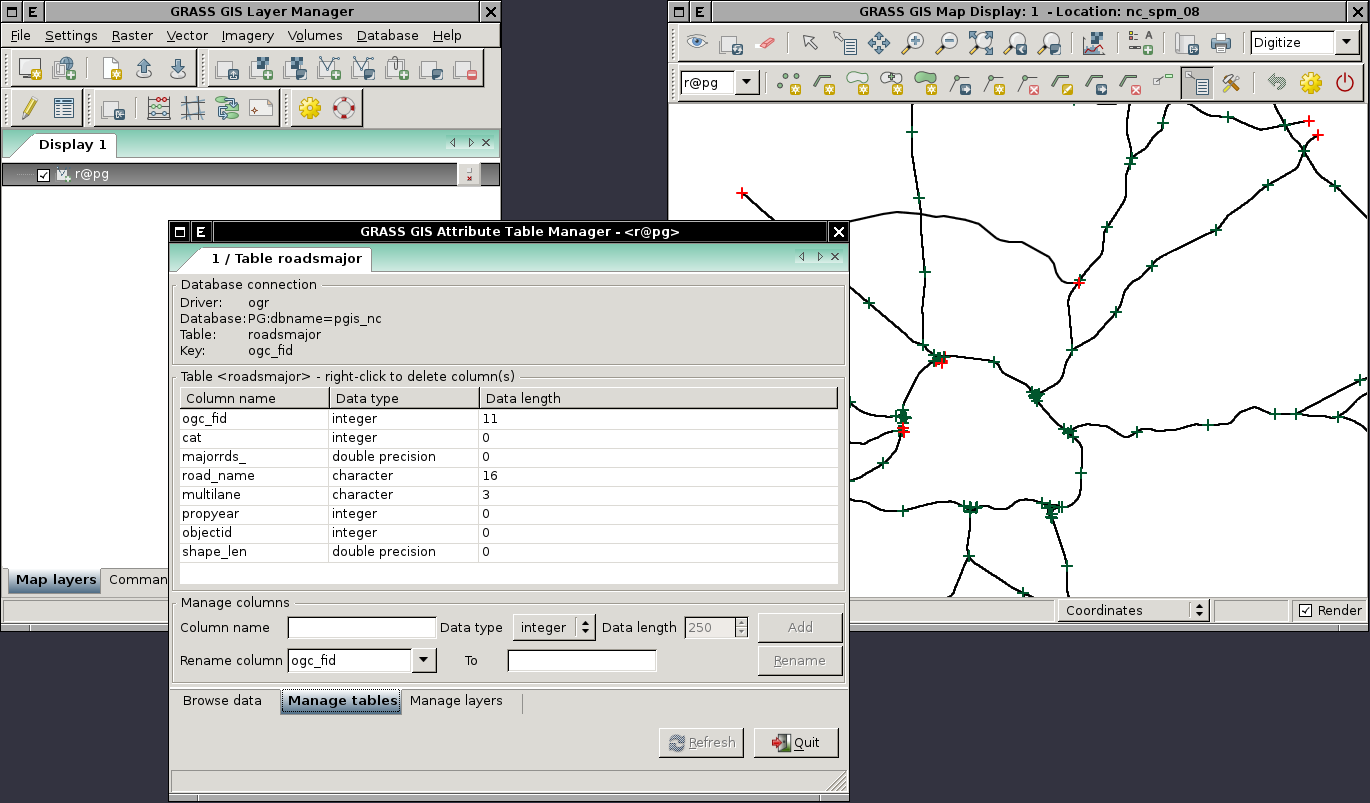
Using wxGUI
From menu
File -> Link external formats

or from toolbar in Layer Manager.
